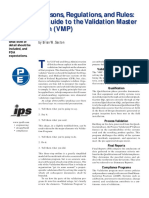0 ratings0% found this document useful (0 votes)
83 viewsWHO Annex 5 2011 - Rev
WHO Annex 5 2011 - Rev
Uploaded by
sitimunawarohThe World Health Organization published supplementary guidelines in 2011 on good manufacturing practices for heating, ventilation, and air conditioning systems for non-sterile pharmaceutical dosage forms. The guidelines provide additional guidance for HVAC systems to ensure quality air and environmental conditions for manufacturing non-sterile drugs. Manufacturers should follow these guidelines to have proper HVAC systems that maintain air quality and help prevent issues that could impact drug quality.
Copyright:
© All Rights Reserved
Available Formats
Download as DOCX, PDF, TXT or read online from Scribd
WHO Annex 5 2011 - Rev
WHO Annex 5 2011 - Rev
Uploaded by
sitimunawaroh0 ratings0% found this document useful (0 votes)
83 views2 pagesThe World Health Organization published supplementary guidelines in 2011 on good manufacturing practices for heating, ventilation, and air conditioning systems for non-sterile pharmaceutical dosage forms. The guidelines provide additional guidance for HVAC systems to ensure quality air and environmental conditions for manufacturing non-sterile drugs. Manufacturers should follow these guidelines to have proper HVAC systems that maintain air quality and help prevent issues that could impact drug quality.
Original Title
WHO Annex 5 2011_rev.docx
Copyright
© © All Rights Reserved
Available Formats
DOCX, PDF, TXT or read online from Scribd
Share this document
Did you find this document useful?
Is this content inappropriate?
The World Health Organization published supplementary guidelines in 2011 on good manufacturing practices for heating, ventilation, and air conditioning systems for non-sterile pharmaceutical dosage forms. The guidelines provide additional guidance for HVAC systems to ensure quality air and environmental conditions for manufacturing non-sterile drugs. Manufacturers should follow these guidelines to have proper HVAC systems that maintain air quality and help prevent issues that could impact drug quality.
Copyright:
© All Rights Reserved
Available Formats
Download as DOCX, PDF, TXT or read online from Scribd
Download as docx, pdf, or txt
0 ratings0% found this document useful (0 votes)
83 views2 pagesWHO Annex 5 2011 - Rev
WHO Annex 5 2011 - Rev
Uploaded by
sitimunawarohThe World Health Organization published supplementary guidelines in 2011 on good manufacturing practices for heating, ventilation, and air conditioning systems for non-sterile pharmaceutical dosage forms. The guidelines provide additional guidance for HVAC systems to ensure quality air and environmental conditions for manufacturing non-sterile drugs. Manufacturers should follow these guidelines to have proper HVAC systems that maintain air quality and help prevent issues that could impact drug quality.
Copyright:
© All Rights Reserved
Available Formats
Download as DOCX, PDF, TXT or read online from Scribd
Download as docx, pdf, or txt
You are on page 1of 2
WHO Annex 5 2011
Supplementary guidelines on good manufacturing practices for HVAC system for non-
sterile pharmaceuticals dosage form
You might also like
- New Changes in ISO 14644-1 - Classification of Air Cleanliness - Pharmaceutical GuidelinesDocument1 pageNew Changes in ISO 14644-1 - Classification of Air Cleanliness - Pharmaceutical GuidelinesMasud HasanNo ratings yet
- QA PharmaceuticalDocument413 pagesQA Pharmaceuticalalhalili100% (9)
- Hydorp Fetalis Complete002Document83 pagesHydorp Fetalis Complete002Sandra Anastasia Gultom100% (2)
- Laboratory GuidelinesDocument1 pageLaboratory Guidelinesmahmoud heakilNo ratings yet
- WHO TRSs IndexDocument6 pagesWHO TRSs Indexchemistosama93No ratings yet
- Annex 2 - 55 Report - HBELs Cleaning ValidationDocument19 pagesAnnex 2 - 55 Report - HBELs Cleaning ValidationKarla Emilia Valencia RamírezNo ratings yet
- Air Quality Matters: A Holistic Strategy and Approach To HVAC System Validation in PharmaceuticalsDocument5 pagesAir Quality Matters: A Holistic Strategy and Approach To HVAC System Validation in PharmaceuticalsInternational Journal of Innovative Science and Research TechnologyNo ratings yet
- Annex 3 WHO TRS 1011 Web-7Document121 pagesAnnex 3 WHO TRS 1011 Web-7Jaime Andrés García BNo ratings yet
- Annex 3 TRS 1011Document99 pagesAnnex 3 TRS 1011Anonymous RuVgQLNo ratings yet
- GUID - 1 en-USDocument19 pagesGUID - 1 en-USDian TheresaNo ratings yet
- WHO - TRS - 996 - annex06-GTDP For Starting MaterialDocument16 pagesWHO - TRS - 996 - annex06-GTDP For Starting MaterialSilver KwongNo ratings yet
- Quality Assurance of Medicines Terminology Database - List of Terms and Related GuidelineDocument181 pagesQuality Assurance of Medicines Terminology Database - List of Terms and Related Guidelinepenelopezeus39No ratings yet
- 1205WHO Vs GMP Slide 16 OnwardsDocument31 pages1205WHO Vs GMP Slide 16 OnwardsTumma RamaraoNo ratings yet
- PQE Group Guidelines To EU GMP Annex 1 Draft 2020Document12 pagesPQE Group Guidelines To EU GMP Annex 1 Draft 2020António Ferreira100% (1)
- PQE Group Guidelines To EU GMP Annex 1 Draft 2020 PDFDocument12 pagesPQE Group Guidelines To EU GMP Annex 1 Draft 2020 PDFparam540100% (1)
- Who Trs 996 Annex04Document16 pagesWho Trs 996 Annex04dikshaNo ratings yet
- Who-Trs 1033 Mar2021-Annex 2-HbelsDocument18 pagesWho-Trs 1033 Mar2021-Annex 2-HbelsGamueNo ratings yet
- Annex 2: Guidelines On Good Manufacturing Practices For The Manufacture of Herbal MedicinesDocument25 pagesAnnex 2: Guidelines On Good Manufacturing Practices For The Manufacture of Herbal MedicinesbishopNo ratings yet
- 2008 02 12 Introduction GMPDocument3 pages2008 02 12 Introduction GMPsanjayghawanaNo ratings yet
- WHO 1033 Annex 2 - Points To Consider For HBELs in CVDocument17 pagesWHO 1033 Annex 2 - Points To Consider For HBELs in CVDevendraNo ratings yet
- GMP Annex 13 - 03 Feb 2010 (Track Changes)Document19 pagesGMP Annex 13 - 03 Feb 2010 (Track Changes)chris2272No ratings yet
- List of Guidelines and Guidance For Pharmaceutical - 230326 - 145451Document18 pagesList of Guidelines and Guidance For Pharmaceutical - 230326 - 145451Dharmesh PatelNo ratings yet
- CPOEDocument10 pagesCPOEMohammad SalehNo ratings yet
- Uma Vasireddy Kakatiya Institute of Pharmaceutical Sciences IndiaDocument31 pagesUma Vasireddy Kakatiya Institute of Pharmaceutical Sciences IndiaAbhishek KumarNo ratings yet
- 2024 TGA GMP Guideline For Medicinal ProductsDocument81 pages2024 TGA GMP Guideline For Medicinal Productsbayan.rihawi95No ratings yet
- Eudralex The Rules Governing Medicinal Products in The European UnionDocument19 pagesEudralex The Rules Governing Medicinal Products in The European UnionMarcM77No ratings yet
- Uncertainty of Measurements Part I Compliance Testing PDFDocument8 pagesUncertainty of Measurements Part I Compliance Testing PDFParkhomyukNo ratings yet
- Q4B Annex 3 R1 Step4Document9 pagesQ4B Annex 3 R1 Step4Udayabhaskar BandarupalliNo ratings yet
- Aceptable, Equivalente o MejorDocument7 pagesAceptable, Equivalente o MejorSINDY PARDONo ratings yet
- Air Handling Systm in Pharmaceutical Manufacturing Pharm R.A. BinitieDocument86 pagesAir Handling Systm in Pharmaceutical Manufacturing Pharm R.A. BinitieApata olutolaNo ratings yet
- 104 Iso 13485 2016 Suitable For Modern Medical Devices IndustryDocument4 pages104 Iso 13485 2016 Suitable For Modern Medical Devices IndustryDr.Sivakumar SelvarajNo ratings yet
- trs1019 Annex4 Classification System Based Classification of Active Pharmaceutical Ingredients For BiowaiverDocument16 pagestrs1019 Annex4 Classification System Based Classification of Active Pharmaceutical Ingredients For Biowaiverايناس ماجدNo ratings yet
- Investigational Medicinal Products:: Regulatory and Practical Considerations For Clinical TrialsDocument17 pagesInvestigational Medicinal Products:: Regulatory and Practical Considerations For Clinical TrialsMODEPHARMANo ratings yet
- Computer System Validation (CSV) : Comparisons Between (GMP VS CGMP, GLP VS GCP, 21 CFR PART 11 VS EU 11)Document4 pagesComputer System Validation (CSV) : Comparisons Between (GMP VS CGMP, GLP VS GCP, 21 CFR PART 11 VS EU 11)T 1No ratings yet
- IVT SDCC pgs6Document42 pagesIVT SDCC pgs6sabrinaNo ratings yet
- How The Different GLP GMP GCPDocument14 pagesHow The Different GLP GMP GCPawang_timur100% (3)
- CleaningValidationConsiderations PEMARCH APRIL2017Document8 pagesCleaningValidationConsiderations PEMARCH APRIL2017essaidnedraNo ratings yet
- E3051 16Document10 pagesE3051 164romi89No ratings yet
- Air Handling System in Pharmaceutical ManufacturingDocument86 pagesAir Handling System in Pharmaceutical ManufacturingVamsiDeepakNo ratings yet
- HarriesDocument3 pagesHarriesIftikhar KhanNo ratings yet
- QAS Terminology DB - List of Terms and Related Guidelines: " Half-Finished " ProductDocument163 pagesQAS Terminology DB - List of Terms and Related Guidelines: " Half-Finished " ProductsadafNo ratings yet
- New 7Th Edition GMP/ ISO Audit Manual For Healthcare Manufacturers and Their SuppliersDocument3 pagesNew 7Th Edition GMP/ ISO Audit Manual For Healthcare Manufacturers and Their Suppliersrouss1906No ratings yet
- Course NotesDocument125 pagesCourse Notesfuji_reihNo ratings yet
- Good Manufacturing PracticeDocument2 pagesGood Manufacturing PracticeBogdan BerariuNo ratings yet
- QualityAssurancePharmVol2 PDFDocument418 pagesQualityAssurancePharmVol2 PDFtsholofelo motsepeNo ratings yet
- Guía de Validación de Limpieza para APIsDocument62 pagesGuía de Validación de Limpieza para APIsJosuePerezNo ratings yet
- Differences Between The PICS EU GMP Guidelines and WHO Guidelines - FinalDocument20 pagesDifferences Between The PICS EU GMP Guidelines and WHO Guidelines - FinalSrinivasaRaoNo ratings yet
- Jun 2017 CPD QMSDocument49 pagesJun 2017 CPD QMSSelvaraj SimiyonNo ratings yet
- ACR Verification Result - 1Document1 pageACR Verification Result - 1sitimunawarohNo ratings yet
- VMP Guide PDFDocument6 pagesVMP Guide PDFsitimunawarohNo ratings yet
- Titanium DioxideDocument5 pagesTitanium DioxidesitimunawarohNo ratings yet
- PRV Venn For Supply Steam U.CDocument5 pagesPRV Venn For Supply Steam U.CsitimunawarohNo ratings yet
- ISO 14644-1:2015 (En)Document1 pageISO 14644-1:2015 (En)sitimunawarohNo ratings yet
- Equipment Hold-Time For Cleaning ValidationDocument10 pagesEquipment Hold-Time For Cleaning ValidationsitimunawarohNo ratings yet
- WHO Annex 5 2011Document2 pagesWHO Annex 5 2011sitimunawarohNo ratings yet
- WHO Annex 5 2011Document2 pagesWHO Annex 5 2011sitimunawarohNo ratings yet
- Chymoral Plus'Document3 pagesChymoral Plus'Neha SureshNo ratings yet
- Pedia AbnormalitiesDocument7 pagesPedia AbnormalitiesRalph Tama Mangacop BenitoNo ratings yet
- "Robodoc". The New Era of The Medical World.Document18 pages"Robodoc". The New Era of The Medical World.Merey SabdenaliyevaNo ratings yet
- Thypoid FeverDocument30 pagesThypoid FeverGlen Jacobs SumadihardjaNo ratings yet
- In Vivo Efficacy of Diospyros Abyssinica Leaf 80% Methanolic Extract From Tooro Botanical Gardens On Wounds Using MiceDocument18 pagesIn Vivo Efficacy of Diospyros Abyssinica Leaf 80% Methanolic Extract From Tooro Botanical Gardens On Wounds Using MiceKIU PUBLICATION AND EXTENSIONNo ratings yet
- DRUG STUDY Vitamin KDocument2 pagesDRUG STUDY Vitamin KChristian Daayata50% (2)
- Anesthesia Website 04jan2019Document18 pagesAnesthesia Website 04jan2019Pranav PujariNo ratings yet
- Mimosa PudicaDocument4 pagesMimosa PudicaIna Guinar100% (1)
- Affirmative Negative Interrogative: 1.-PeopleDocument3 pagesAffirmative Negative Interrogative: 1.-PeopleNAYELI DIRROSS MARTINEZ NUNTONNo ratings yet
- Oreganum Vulgare Oreganum Vulgare Oreganum Vulgare Oreganum VulgareDocument2 pagesOreganum Vulgare Oreganum Vulgare Oreganum Vulgare Oreganum VulgareCatherine R. FelipeNo ratings yet
- Guide To The Dissection of The Dog 7th Edition Session1Document5 pagesGuide To The Dissection of The Dog 7th Edition Session1side0520No ratings yet
- JurnaladadsadwqeDocument1 pageJurnaladadsadwqeOka Robi MuhammadNo ratings yet
- Polisitemia SekunderDocument4 pagesPolisitemia SekunderAldi RafaelNo ratings yet
- Management of Behavioural Disoder of ChildrenDocument28 pagesManagement of Behavioural Disoder of ChildrenKiran KhasaNo ratings yet
- Tkrout CVDocument8 pagesTkrout CVapi-748224285No ratings yet
- 2697 PDFDocument5 pages2697 PDFSeptya widhiafniNo ratings yet
- 12 - Chapter 4Document38 pages12 - Chapter 4Tayyab TahirNo ratings yet
- Kinesiology-I: Introduction To Manual Muscle TestingDocument12 pagesKinesiology-I: Introduction To Manual Muscle TestingKanwal Khan100% (1)
- 2.2 Gyn Pathology OvaryDocument0 pages2.2 Gyn Pathology OvarydinapurpleloversNo ratings yet
- Day Case Open Appendectomy: A Safe and Cost-Effective ProcedureDocument9 pagesDay Case Open Appendectomy: A Safe and Cost-Effective ProcedureAcademecian groupNo ratings yet
- Fluorosis: Fluoride Toxicity: Patient Management & MonitoringDocument24 pagesFluorosis: Fluoride Toxicity: Patient Management & MonitoringdrjriNo ratings yet
- 9700 w02 QP 5Document8 pages9700 w02 QP 5hasnainf11280No ratings yet
- VLCCDocument25 pagesVLCCpepadi4585No ratings yet
- TOACS Osce07-110918053859-Phpapp02Document12 pagesTOACS Osce07-110918053859-Phpapp02Furqan MirzaNo ratings yet
- m7 A3 Hoffman CP ViiDocument23 pagesm7 A3 Hoffman CP ViiGerry Hoffman100% (1)
- Guntur District DHB - 2013Document287 pagesGuntur District DHB - 2013Sai PrajitNo ratings yet
- Hep BquinDocument2 pagesHep BquinIvan Rangga GunawanNo ratings yet
- Defibrillators, External, Automated Semiautomated - 030223112503Document105 pagesDefibrillators, External, Automated Semiautomated - 030223112503CLAUDIA PAOLA HOLGUIN VELEZNo ratings yet
- Chap 1. Hospital PharmacistDocument29 pagesChap 1. Hospital PharmacistUbaid KhanNo ratings yet




















































































